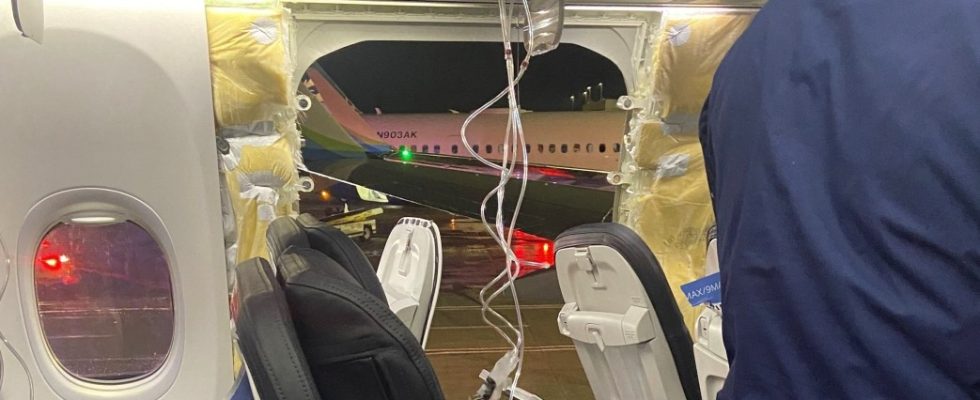An Alaska Airlines plane lost part of its fuselage during flight. The incident occurred on the way from Portland, Oregon to Ontario Airport, which is located east of Los Angeles, California – at an altitude of 4,900 meters. Shortly after takeoff, the machine is of type Boeing 737 Max-9 returned to Portland airport with 171 passengers on board and made an emergency landing there.
According to media reports, part of the cabin wall suddenly came loose and flew away. There was a big bang and then air rushed out through the hole, passengers told the newspaper The Oregonian. The seat directly next to it was unoccupied, but a teenager in the middle seat suffered injuries from the sudden drop in pressure. There were therefore no reports of serious injuries.
The New York Times reported, some of the Boeing 737 Max-9-Aircraft have fewer seats than the maximum number of seats permitted for that aircraft type. In this case, the machine also requires fewer emergency exits. This was also the case with the Alaska Airlines model. Machines with fewer seats have a placeholder of sorts where fully loaded models would have an emergency exit.
The hole on the side of the plane can be seen in a passenger video published by the BBC. “It wasn’t even the emergency exit. It was just part of the plane,” a woman said in the video.
US Federal Aviation Administration orders immediate inspections
After the incident, the US Federal Aviation Administration (FAA) ordered a temporary grounding of more than 170 aircraft of the type. The authority announced on Saturday that immediate inspections of certain aircraft of this model were necessary, which would take around four to eight hours per aircraft. Only then could the affected aircraft go back into operation. This applies to aircraft operated by US airlines or traveling on American territory – 171 aircraft worldwide.
The incident now also has consequences in Europe. The British aviation regulator CAA said on Saturday evening that it had written to all non-British airlines asking them to confirm that they carry out safety checks before entering British airspace. There are no machines of this type in Great Britain itself Boeing 737 Max-9 registered.
The European Aviation Safety Agency (EASA) has adopted the American Federal Aviation Administration (FAA) directive for the Boeing 737 Max-9 accepted. However, EASA noted that no airline from an EU member state “is currently operating an aircraft in the affected configuration.”
Alaska Airlines had previously announced all of its 737 Max-9 to leave on the ground for now. As a precautionary measure, it was decided to subject the 65 machines to thorough maintenance and safety checks, the company announced late on Friday (local time). Each machine will only be put back into operation after an inspection has been completed. “My condolences go out to those who were on this flight – I am so sorry for what you experienced,” said the statement from company boss Ben Minicucci.
The aircraft was not produced until 2023
Federal Aviation Administration data, the Federal Aviation Administration of the United States, show that the affected aircraft (number N704AL) is a very new one. The aircraft was not produced until 2023 and was certified in November last year.
In contrast to the benign outcome on Friday, two emergencies in 2018 and 2019 ended catastrophically and led to a starting ban 737-Max-Row. There were a total of 346 deaths in the two crashes. The main cause is believed to be a faulty control program that caused the machines to crash to the ground. Boeing then revised the type and gradually received re-certifications. However, the medium-haul jet continued to make headlines with production defects and put a strain on the manufacturer’s balance sheets.

